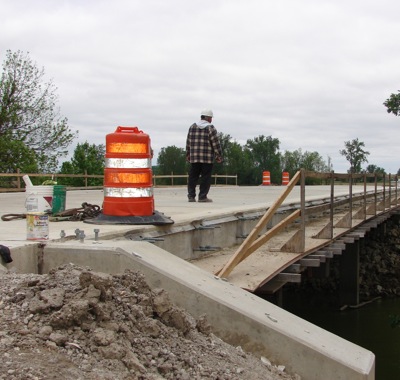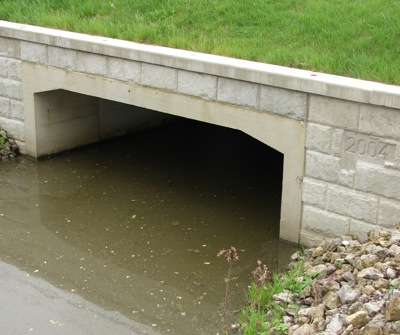Friday, May 18th, 2007
Auglaize County bridge work done at cost savings
By Janie Southard

Photo by Janie Southard/The Daily Standard
The bridge on state Route 49 over the Wabash River in Mercer County is being built by contractor Eagle Bridge of Sidney. This $1 million project also includes a second bridge on state Route 49 in Mercer County. These two bridges represent the largest ODOT project in the county this year.
WAPAKONETA - During the past 23 years Auglaize County highway crews have manufactured and installed more than 250 bridges with more than 10-foot spans and rehabilitated 20 bridges of varying lengths. Quite a record and quite a savings to the county budget, according to Auglaize County Engineer Doug Reinhart.
"Because we can do so much in house, our costs average $150 per running foot as compared to the standard contractor's average of $600 per running foot," Reinhart said, adding that employees already are on the payroll and a bridge project is an easy fit between snowstorms in the winter.
Depending on size, some bridges have been poured and installed in less than eight days even when counting the time to remove the old structure.
"We get all the components poured and cured here at the (highway garage facilities). Then after we take out the old structure on site, it's almost like laying down Lincoln Logs," Reinhart said.
In the 2006 bridge/culvert program, the department poured 535 cubic yards of concrete and 11.3 miles of reinforcing steel was used in building bridge beams, three-sided boxes (a type of small bridge), headwalls and footers.
"Because of the size of our casting forms and the lifting ability of the crane, a 35-foot long beam is the longest we can manufacture," Reinhart said.
He said the county is perched on the continental divide and several large rivers begin locally. About one third of the county's streams and rivers run south toward the Gulf of Mexico. The other two-thirds run north to Lake Erie.
"That means the majority of our bridges have short spans, which lets us build our own beams and boxes. It's a big savings to taxpayers," he said.
Another significant savings may be on the horizon if state Rep. Jim Zehringer, R-Fort Recovery, is successful in getting a bill through the state Legislature to revise the language in the Force Account Law.
The Force Account Law is part of the Ohio Revised Code and stipulates which projects, based on estimate cost, are required to go out for bid and therefore, cannot be done in house by city crews.
The law has been around since 1917 and has been revised many times along the way. As of July 2003, project estimates exceeding the following limits must go out for bid: More than $100,000 per bridge and more than $30,000 per mile for road improvement.
Prior to 2003 the last adjustment was in 1972 and that time there was no consideration given to inflation.
And, inflation has taken its toll.
"There is nothing in the law to allow for inflation and, as you know, the cost of materials has skyrocketed over the past few years. Just since 2003 the cost of oil, steel, concrete, etc. has increased 41 percent," Reinhart said.
Since his department only works on the smaller projects, he can't make comparisons as to possible savings in doing work in house as compared to contractors.
But, can his crew handle the big projects?
"Absolutely. I'd love (the state) to let me build a $250,000 bridge. Then we could compare costs ... I know we could do it here for 33 percent less than a contractor could," he said. "For one thing there's no profit involved. All we could get ahead on (in terms of money) would go back into our next bridge project."
And this is where he hopes Zehringer can step in.
"We are in the beginning stages of raising the Force Account," Zehringer said from his Columbus office. "Presently we're setting up meetings with township trustees, commissioners and ODOT representatives as well as building and contractors associations. We hope to come up with figures that county engineers Reinhart and (Jim)Wiechart (Mercer County) can work with."
The representative said he has been asked to shepherd the legislation through the House and believes it will "really help control costs and keep a lot of employees busy during slower seasons.
"The drawback and the argument will be that raising the monetary amounts will take work away from the public sector. Certainly this will take some negotiating," Zehringer added.
Meanwhile, the Auglaize crew is busy with the 2007 bridge/culvert program, which calls for at least 19 projects requiring 435 cubic yards of concrete.
Of the 375 bridges in Auglaize County not one has weight limitations posted, a sure indication the program is efficient and effective.

Photo by Janie Southard/The Daily Standard
The Auglaize County bridge on Fourth Street over the Miami & Erie Canal in Minster, was completely built and installed by Auglaize County Highway Department employees in 2004. Although it looks like limestone, it is actually concrete poured in a mold to resemble limestone.




